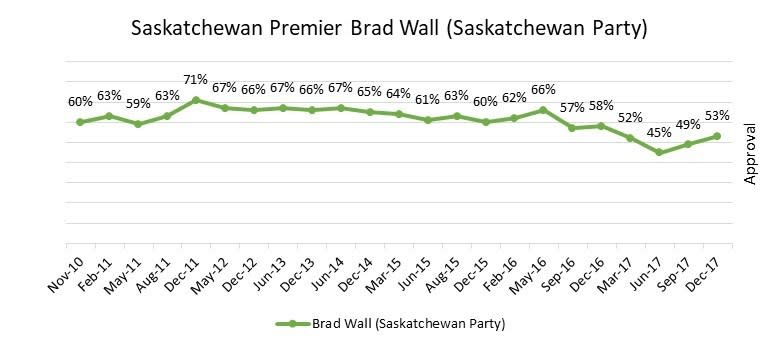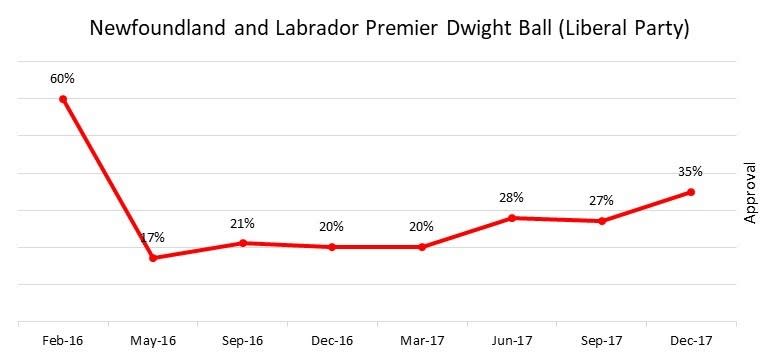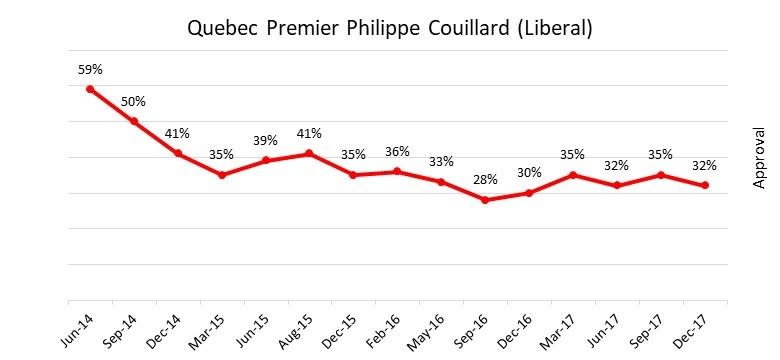Saskatchewan's Brad Wall has the highest voter rating in Canada
As Canadians set their sights on the new year, they’re giving their premiers one final grade for the year. But asides from Saskatchewan Premier Brad Wall and B.C. Premier John Horgan, there isn’t much good news for the country’s provincial leaders.
It comes as no surprise that outgoing Saskatchewan premier topped the list, with 53 per cent of voters saying they approve of him. Wall was the only provincial leader that had the support of more than half the population, a position he has maintained for the better part of a decade. He was first voted into office in 2007. His Saskatchewan Party has also done incredibly well under his leadership, winning 61 or 71 seats during the 2016 provincial election.

The second most popular premier in the country was newly-elected B.C. premier John Horgan, who had the approval of 49 per cent of his constituents. Granted, Horgan has only been in office for a single quarter, and as he occupies more time in office, more voters will have a stronger opinion of his performance. His government recently approved the Site-C dam, a hotly contested issue in the province, but has also called for a referendum on electoral reform, placing many B.C. voters in an awkward political position.
Approval ratings drop precipitously for all of Canada’s other premiers though. The next most popular premier is Newfoundland’s Dwight Ball, who polls at 35 per cent approval. Ball was voted into office in 2015, defeating the Progressive Conservatives. The premier enjoyed a high approval rating of 60 per cent as recently as February 2016. But a dramatic drop in the price of oil and a $1.8 billion deficit left by the previous government forced Ball’s Liberals to raise taxes and cut services. His approval rating bottomed out at 17 per cent as a result.

Three premiers have the approval of just one-in-three of their constituents: Alberta Premier Rachel Notley, Manitoba Premier Brian Pallister and Quebec Premier Philippe Couillard. Notley and Couillard both enjoyed approval ratings above 50 per cent when they were first elected into office.
Both premiers were initially not even considered as possible contenders when their provincial election campaigns started. The Progressive Conservatives in Alberta had ruled the province for a generation, and most political observers thought it was impossible that a left-wing party could ever win there. Meanwhile, the Parti Quebecois had a good chance of forming government again at the start of the election campaign but mismanaged the election campaign, leading to a Liberal sweep in April 2014.
Alberta’s premier had the approval of 53 per cent when the NDP ended 44 years of Progressive Conservative rule in the province. A sizeable segment of voters were likely motivated to vote against the incumbent party when Premier Jim Prentice effectively blamed Albertans for their economic woes. Since then, Notley has had to grapple with the continuing effects of a downturn in the price of oil, the same issues that led to the downfall of her predecessor. She and her party are up for re-election in 2019, facing down the newly created United Conservative Party.

Quebec’s premier enjoyed an even higher approval rating, coming into office at 59 per cent approval, riding off a series of own-goals by the Parti Quebecois, namely choosing Pierre Karl Péladeau, who revealed his unabashedly separatists views, as party leader during the vote. The Liberals’ victory showed that Quebecers weren’t interested in reopening the sovereignty debate during the election. Couillard’s government is up for reelection in the fall of 2018.

Manitoba’s premier saw his support peak at 53 per cent in September 2016, after ending 17 years of NDP rule over Manitoba. Since then, his approval rating has been eroded, dropping to 34 per cent, partly as a result of allegations that he owned three parcels of highly valued land on the Costa Rican coast.

Kathleen Wynne had the lowest approval rating of any premier, a position she has consistently occupied among this current crop of provincial leaders. Her approval rating was just 20 per cent, which while quite low, has risen eight points since March 2017, when she polled at 12 per cent approval. The passing of the $15 minimum wage, free pharmacare for people under 24 and a series of other progressive measures meant to shore up support for the party ahead of a tough reelection fight.



